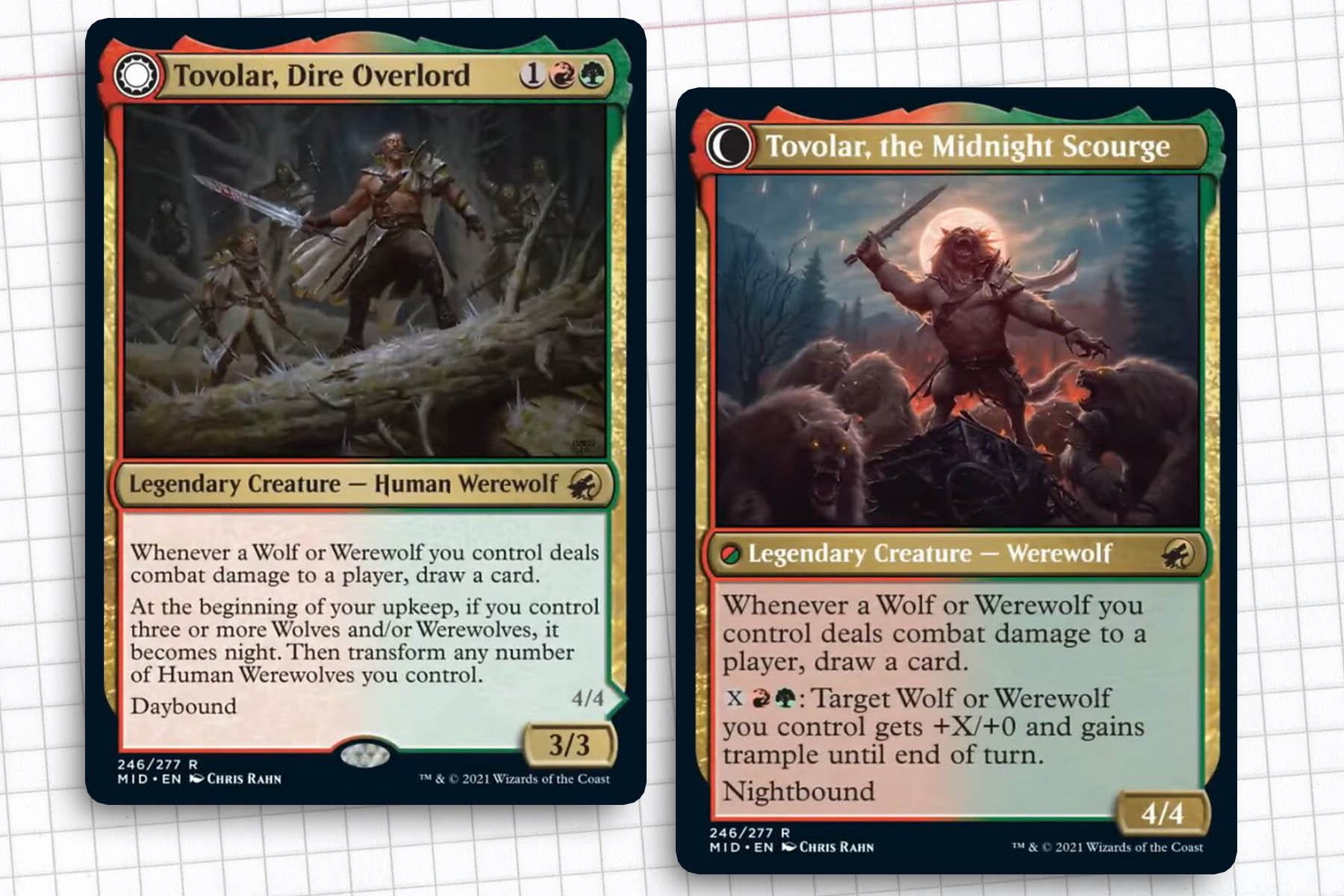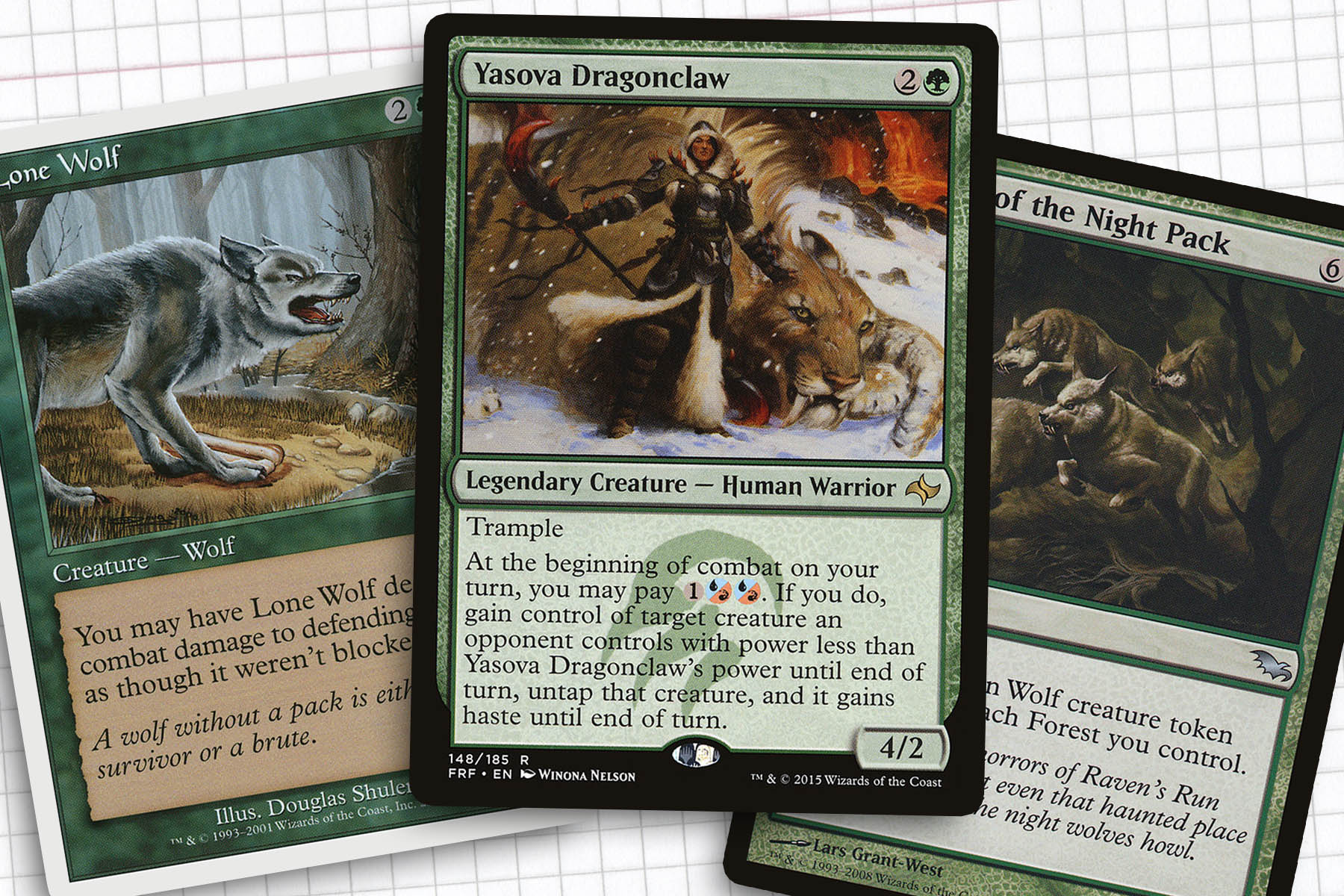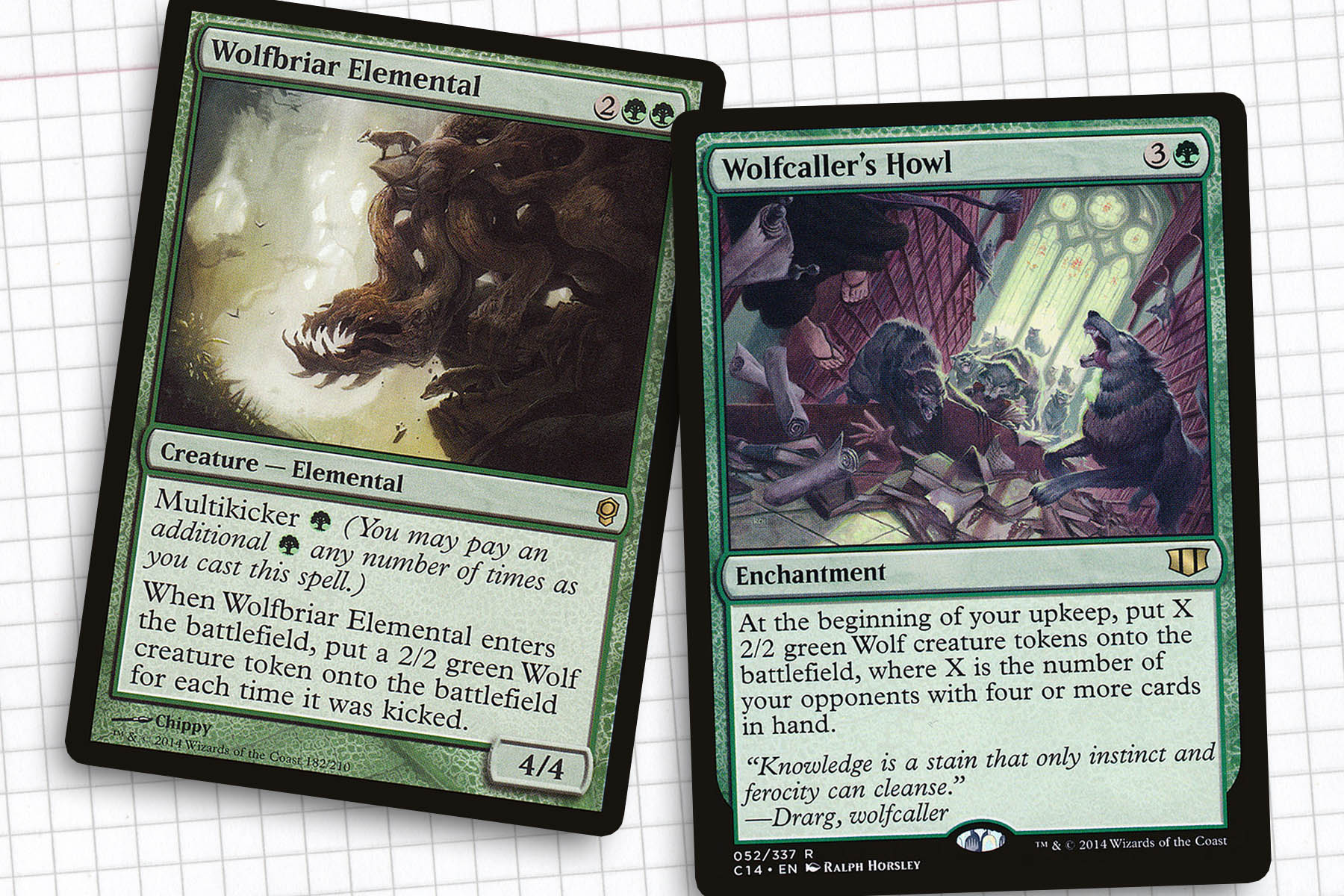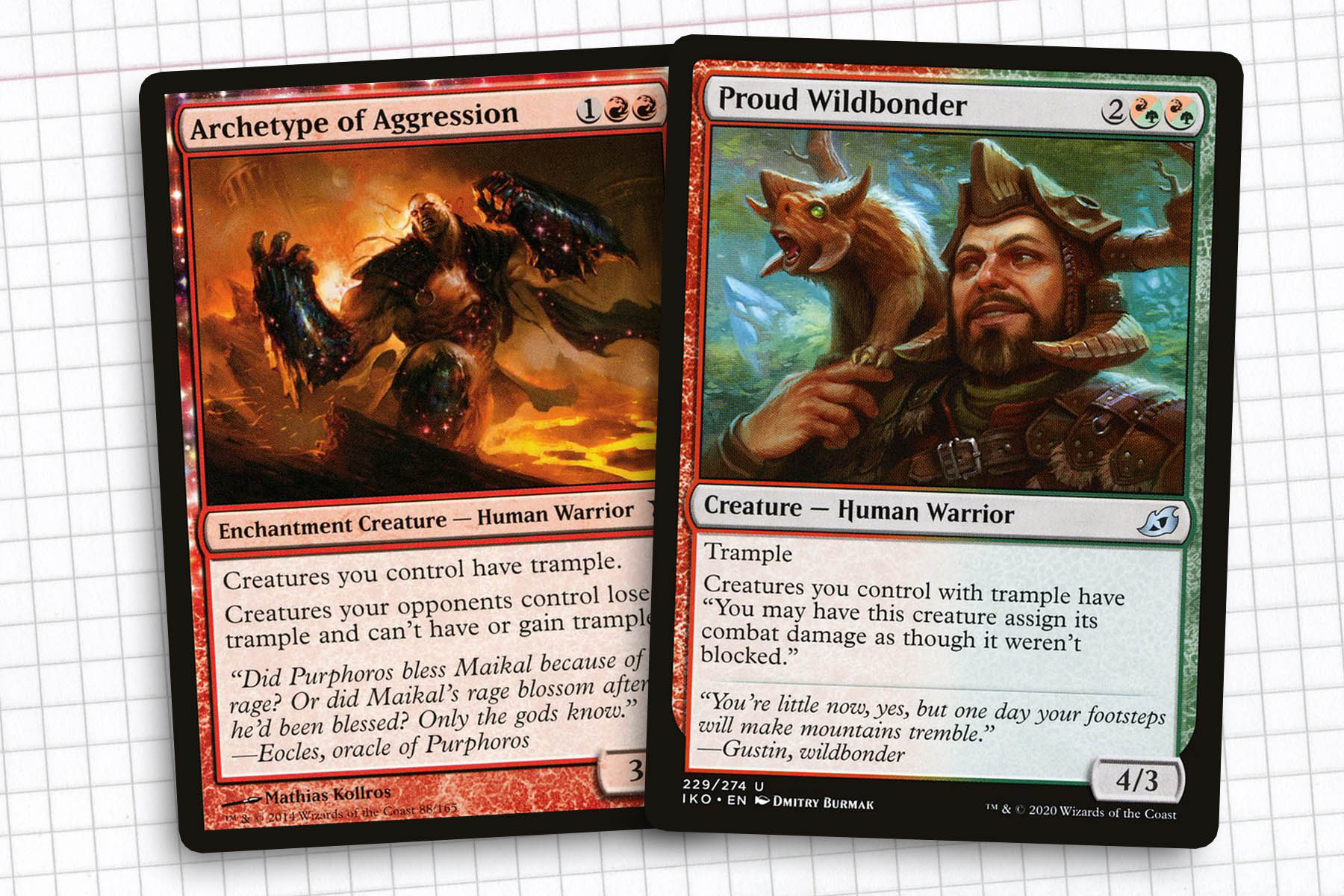As someone who plays a lot of Commander, I have built many decks but not kept them assembled for long. Within the pantheon of my Commander decks, I have only a few that have been able to survive more than five years: Ib Halfheart, Goblin Tactician, Doran, the Siege Tower, Shattergang Brothers, and today’s deck. All of these were made with a mission statement in mind when they were being assembled and have never seen a transition from the original general into someone new without being reverted back within a few months.
For one reason or another, the new builds lost their original style I had been building towards and it left me dismayed enough that I went back to square one. This week, thanks to Tovolar, Dire Overlord, I think I’ve finally found the general that captures what I had initially wanted to do.

Today is the culmination of almost two decades of love for wolves, seven of which being expressed through a Commander deck. Simply put, they are a beautiful real-life animal, brought into our game embodying their pack mentality and savage nature. Let’s see how Tovolar has proven to have what it takes to embody the style and gameplay I have been looking for.
Commander: Tovolar, Dire Overlord
Creatures: Anara, Wolvid Familiar, Archetype of Aggression, Assembled Alphas, Deranged Whelp, Exuberant Wolfbear, Fearless Pup, Ferocious Pup, Goblin Anarchomancer, Hound Tamer, Howling Giant, Huntmaster of the Fells, Immerwolf, Instigator Gang, Kessig Naturalist, Moraug, Fury of Akoum, Nightpack Ambusher, Nylea, God of the Hunt, Outland Liberator, Proud Wildbonder, Pyreheart Wolf, Ruin Grinder, Spirit of the Hunt, Tovolar’s Huntmaster, Ulrich’s Kindred, Village Watch, Wandering Wolf, Wolf of Devil’s Breach, Wolfbriar Elemental, Xenagos, God of Revels, Young Wolf
Planeswalkers: Arlinn, the Pack’s Hope
Enchantments: Berserkers’ Onslaught, Breath of Fury, Feed the Pack, Howlpack Resurgence, Perilous Forays, Unnatural Growth, Wolfcaller’s Howl, Zendikar Resurgent
Artifacts: Everflowing Chalice, Rhonas’s Monument, Sword of the Animist, Traveler’s Amulet, Wayfarer’s Bauble
Instants: Deglamer, Second Harvest, Unravel the Aether, Valakut Awakening, Volcanic Offering
Sorceries: Caravan Vigil, Far Wanderings, Full Flowering, Ghired’s Belligerence, Grow from the Ashes, Howl of the Night Pack, Mizzium Mortars, Predatory Focus, Rishkar’s Expertise, Shamanic Revelation, Traverse the Outlands, Traverse the Ulvenwald
Lands: 11 Forest, 7 Mountain, Ash Barrens, Blighted Woodland, Cinder Glade, Cragcrown Pathway, Game Trail, Gruul Turf, High Market, Highland Forest, Kazandu Refuge, Kessig Wolf Run, Looming Spires, Oran-Rief, the Vastwood, Rockfall Vale, Rootbound Crag, Rugged Highlands, Sheltered Thicket, Shivan Oasis, Stomping Ground, Temple of Abandon, Turntimber Grove

The Pack’s Calling
The inspiration for the lineage of this deck started almost immediately upon learning about Magic: the Gathering. I saw a copy of Lone Wolf; and having begun my involvement with the game just as Onslaught was coming out, I wanted to build a sixty-card tribal deck around it. This proved to be more difficult than I might have imagined, as outside of Lone Wolf, only Howling Wolf and Arctic Wolves seemed promising. The next few years were also not kind, bringing Tel-Jilad Wolf, Watchwolf, and Howl of the Night Pack, but little else. As such, it wasn’t until I first opened Master of the Wild Hunt during a Magic 2010 draft that I felt any urge to continue pursuing my original pet deck.
Patience has really paid off though: the rise of Commander, in tandem with some design space being carved out by Wizards, presented a viable avenue for my Wolves deck. For years wolves had been a tribe in name alone; then in the original Innistrad, wolves took on an identity as mana sinks as a necessity to support the werewolf tribe. Wolves like Darkthicket Wolf, Somberwald Alpha, and Ulrich’s Kindred all offered an outlet for our mana. By pumping themselves or our team meant that wolves had a modicum of staying power. And as of four years ago, I was writing about my Yasova Dragonclaw Wolves deck.
My Yasova build has stayed mostly intact, accumulating a few recent cards like Kiora, Behemoth Beckoner and Moritte of the Frost. Despite being physically present in my rotation of decks, I had lost a great deal of passion for it and was hardly looking for cards that would measurably improve it, to the degree that I had not gotten a copy of Ketria Triome into the deck in the last year. The deck had developed a bit of an identity crisis, rooting itself more in Threaten effects than wolves over time, something I was too apathetic to address.
With the release of Tovolar, Dire Overlord, I finally saw a new age of the deck coming into focus. While a lot of people were excited by the potential of a werewolf commander that thrived where Ulrich of the Krallenhorde couldn’t, I was jumping out of my chair for the tribal support extended to wolves. Tovolar’s Kessig Wolf Run effects partnered with Village Reavers, Lord of the Ulvenwald, and Untamed Pup gave wolves adequate support to make them threats in combat. Additionally, Tovolar coming down and acting like Coastal Piracy means that not only does he replace himself, but provides the card selection needed to level the playing field against meatier decks.

Old Reliable Tokens
Wolves have existed as a semi-token tribe since Legends with Master of the Hunt, but they didn’t come into their own as 2/2 creature tokens until Lorwyn block with Wren’s Run Packmaster and Wolf-Skull Shaman. From Zendikar forward, we’ve gotten a steady stream of wolf token creators, with Wolfbriar Elemental, Huntmaster of the Fells, Raised by Wolves, and Nightpack Ambusher being a few of my personal favorites. For this deck, I knew I was going to need to rely on a suite of token makers to help round out the deck list, including exploring Full Flowering and Ghired’s Belligerence, both of which I had not played with before this build.
First off, I will freely admit, I did not process Tovolar’s Huntmaster correctly. On my first reading I overlooked the attack trigger on the nightbound side and didn’t realize it was a pretty close approximation of Grave Titan, causing me to do a double take during my playtesting. The tried and true duo of Feed the Pack and Wolfcaller’s Howl are here to not only keep my board sizable, but also to ensure that Tovolar’s trigger to automatically turn day to night is always viable, bringing all the old school werewolves with him. And then there is my go-to favorite, Wolfbriar Elemental, able to redeploy an army of wolves after a board wipe or team up with Village Reavers as a surprise swarm when I want to definitively close out the game.
In tandem with all the different versions of anthem effects—Berserkers’ Onslaught, Immerwolf, and Unnatural Growth, to name a few—this token swarm has already proven to be formidable. Tovolar drawing us cards means that we’re never really out of the game and we may even be able to cast a few extra spells to ensure that we can go daybound and transform a few of our old school werewolves if they missed the sunset earlier in the game. But the real power is in the Kessig Wolf Run, if we haven’t granted our team trample passively already.

Overwhelming Victories
While you can very easily win games by just attacking on the regular and taking advantage of Xenagos, God of Revels, granting the team trample is a fast track to victory. I discovered early on that I best pay special attention to where I could fit cards into the deck that would ensure that I didn’t need to depend solely on my general to grant the all-important ability. Ultimately, I landed on Archetype of Aggression, Hound Tamer, Howlpack Resurgence, and Nylea, God of the Hunt as the dependable suite.
In the end, Instigator Gang and Proud Wildbonder are really the finishers for this deck. Magic has absolutely changed since I originally started playing the game. In that way, it’s hard to properly contextualize just how threatening Thorn Elemental was when used against players who had not accurately understood resource management. But when every creature is getting the bonus from Wildblood Pack and blocking does not change the damage you’re about to take, you find yourself sitting out real quick. In the games I have played, a few times the optimal way to take a player out of the game is to drop Proud Wildbonder and then attack into a player, activating Tovolar, the Midnight Scourge’s activated ability with X equal to zero, just to give our creatures trample and turn them into Thorn Elementals.
Concluding Thoughts
There was some consternation initially that Tovolar might have been a little too powerful. In practice, I don’t really feel like there’s much need to be alarmed: our general is sitting at a medium high power level, but certainly not broken. I fully expected this deck to be an immediate favorite of mine—but I didn’t quite expect that before even having all the cards I needed, a suboptimal version would hold its own in the wild. Tovolar is a card draw engine by itself, but Wildblood Pack in combination with our general meant that a single attack was presenting a minimum of fifteen damage.
The deck is aiming to win through straightforward combat and it does just that. In contrast, my Ib Halfheart deck wins through combat, but it’s done such in a way that it might as well be a combo deck. And similarly my Shattergang Eldrazi deck certainly tries to win through combat, but only after throwing big haymaker creature spells. I like how my Tovolar deck wants to play at a medium power level while being able to close the game after half a dozen turns, if the table is already moving at that speed.
Ryan Sainio is a Graphic Designer who writes about EDH and the EDH community. He has been playing Magic: the Gathering since 7th Edition in 2002 and values flavorful and fun gameplay over competitively optimized decks.

